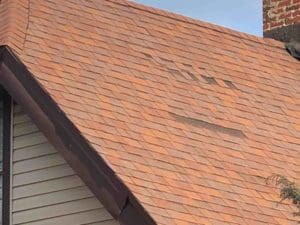The nailing zone is a manufacturer-required nailing area just below the center of the shingles. Manufacturers have specific instructions for installation companies. They tend to give about 3/4″ to work with in order to optimize the grip strength each nail has to hold down the shingle. But it is not the nailing zone alone that holds down all shingles.
Each shingle is secured down with 3 connection points
Sealants
The sealants are on the back of the shingle, about 1/2″ from the bottom. The sealants help to bind the shingle to the shingle just below it. Those sealants, sometimes called adhesives, activate when the temperatures begin to rise. They also make it so that, once activated, your roof becomes like one giant connected shingle, each bound to, and supporting the next.
Nailing Zone
This 3/4″ section is just below the middle of the shingle, but above what you will see for the remainder of your roof’s life. The nailing zone, if properly installed, should have about 5 nails in it if you live in a state in the northern zone like Wisconsin. The nailing zone is the area of the double laminate on an architectural shingle and is therefore the thickest part of a shingle. Shingle Manufacturer, Owens Corning has added even more technology to enhance the nailing zone.
Headlap
If you lay out your shingles on a flat surface, look for the nailing zone. If it is covered, you will notice that the nailing zone of the shingle above it has a nailing zone that hits the top of the shingle underneath it as well. This area, if the shingle is properly nailed, will result in twice as many nails holding down your shingles because the nailing zone of the third shingle up hits the headlap of the first shingle down. If the shingle only has nails along the top, it’s called “high nailing” and is not acceptable to any manufacturer, let alone any qualified roofer.
The Dangers of High Nailing – Shingle Blowoff

A common problem we see is easily avoidable and had the contractor, or homeowner if it was a DIY project, read the wrapper on the shingles themselves, this would have been avoided. We often see nails right along the top of the shingle. This may work for a short period of time, but eventually, they let loose. When a shingle gets fastened high, the third connection point for the shingle below is missed and therefore more prone to being blown off. Shingle “Blow-off” occurs when the wind gets underneath the shingle and blows some or all of the nails through leaving the shingle hanging.
So instead of having 3 connection points, you only have 2. And with only 2 connection points, there is less to hold the shingle on with, and more pressure is put on the weak points.
While the homeowner could choose a repair, this could be a sign that part or the whole roof was high nailed. A further roof inspection could reveal a clearer direction.

